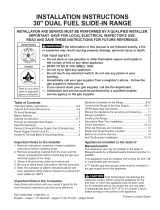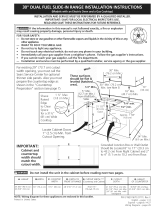
15
INSTRUCCIONES DE INSTALACIÓN PARA LA ESTUFA ELÉCTRICA
DESLIZABLE DE 30"
Los controles eléctricos pueden
ser dañados con frías temperaturas. Cuando utilice su
estufa por la primera vez, o si no ha sido utilizada por
mucho tiempo asegúrese que no haya sido expuestas a
temperaturas más altas que 0°C/32°F por más de 3 horas
antes de conectar su estufa al suministro eléctrico.
• Asegúrese que su cocina está instalada y
conectada adecuadamente a tierra por un
instalador calicado o un técnico de servicio.
• Esta cocina debe ser conectada a tierra
eléctricamente de acuerdo con los códigos
locales, o de no existir, con la National Electrical
Code ANSI/NFPA No.70- última edición en el
estados unidos o con la CSA Standard C22.1,
Canadian Electrical Code, Part 1 en el Canada.
• La instalación de electrodomésticos destinados
para casas (movibles) deben conformarse con
la Manufactured Home Construction and Safety
Standard, título 24CFR, parte 3280 [antiguamente
la Federal Standard for Mobile Home Construction
and Safety, título 24, HUD (parte 280)] o cuando este
código no se aplica, la Standard for Manufactured
Home Installation 1982 (Manufactured Home sites,
communities and setups) ; ANSIZ225.1/NFPA 501A-
última edición o con códigos locales en el estados
unidos o con CAN/CSA-Z240 MH en el Canada.
• Asegúrese que el empapelado de pared alrededor
de la cocina pueda resistir el calor generado por
la cocina.
• Antes de instalar la cocina en una área cubierta
de linóleo o cualquier otro revestidos de piso
sintético, asegúrese que éste pueda resistir al
menos 90°F (32,2°C) sobre la temperatura de la
pieza sin encogerse, ladearse o descolorareis. No
instale la cocina encima de una alfombra a menos
que coloque una placa de aislamiento o una plancha
de ¼" (0,64 cm) de madera entre la cocina y el
alfombrado.
Nunca deje a los niños solos o
sin cuidado en el area donde el electrodoméstico
está en uso. A medida que los niños crezcan,
enséñeles el uso adecuado de los electrodomésticos.
Nunca deje la puerta del horno abierta cuando la cocina
esté sin supervisión.
Pisar, apoyarse o sentarse
en las puertas o los cajones de la cocina pueden
causar graves heridas y también dañar la cocina.
• No coloque cosas que atraigan a los niños sobre
los gabinetes encima de la cocina. Los niños
podrían sufrir quemaduras tratando de alcanzarlos.
• Para evitar riesgos de quemaduras o incendios
al tocar supercies calientes, se deben evitar los
armarios sobre la supercie de los quemadores.
Si existe un armario, se pueden reducir los
riesgos instalando una campana que se extienda
horizontalmente en un mínimo de 5" (12,7 cm) por
sobre la parte inferior de los armarios.
• No use el horno como espacio de almacenamiento.
Esto crea una situación muy peligrosa.
• Nunca use su cocina para calentar la pieza. El uso
prolongado de la cocina sin ventilación adecuada
puede ser peligroso.
• No guarde o use gasolina u otros vapores
inamables y líquidos cerca de éste o cualquier
otro electrodoméstico. Esto podría causar una
explosión o un incendio.
• Vuelva a programar todos los controles a
la posición "off" (apagado) después de haber
utilizado el conteo contador automático.
IMPORTANTES INSTRUCCIONES DE SEGURIDAD
Este manual contiene importantes mensajes de seguridad. Siempre lea y obedezca todo mensaje
de seguridad.
Indica una situación muy peligrosa, la cual de no ser evitada puede ocasionar graves
heridas y hasta la muerte.
ATENCION
Indica una situación de peligro inminente, la cual de no ser evitada puede
ocasionar heridas leves o daños al producto solamente.
• Un niño o adulto puede volcar la estufa
y acabar muerto.
• Vericar que el braquet trasero
este calibrado con la cubierta o el
utensilio del anti-vuelco sea instalado
Riesgo de volcamiento
en las paredes del cabinete como la indican las
instrucciones.
• Asegurar que el braquet antivuelco sea calibrado con la
cubierta o los lados de la cabina así como lo indican las
instrucciones cuando la estufa sea movida.
• No utilice la estufa sin el dispositivo antivuelco instalado
y acoplado.
• Si no se siguen estas instrucciones, se puede provocar la
muerte o quemaduras graves en niños y adultos.
Para vericar si la jaciones de anti-inclinación
está instalado correctamente, sostenga el
borde trasero de la parte trasera de la estufa
usando ambos brazos. Intente inclinar la
estufa hacia adelante con cuidado. Si está
instalada correctamente, la estufa no debería inclinarse
hacia adelante.
Consulte las instrucciones de instalación del soporte
antivuelco proporcionadas con la estufa para instalarlo
adecuadamente.






















